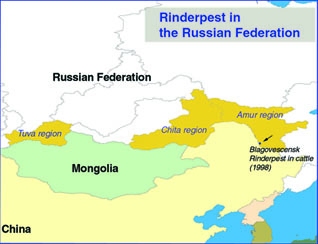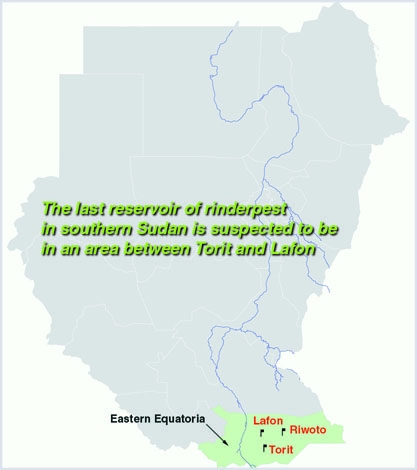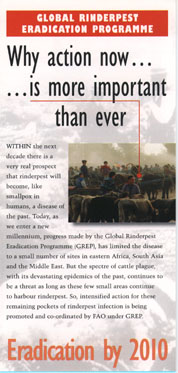

The National Workshop on Rinderpest Epidemiology, Surveillance and Control was conducted by Dr Peter Roeder (FAO Animal Health Officer - GREP Secretary) and Dr William Taylor (Consultant Rinderpest Epidemiologist) in Islamabad, Pakistan, under the auspices of the TCP project from 21 to 24 February 2000, to start implementation of the project.
The participants were directors-general and/or directors of livestock/animal husbandry for the provinces of Balochistan, North-West Frontier, Punjab and Sindh, and for the Northern Areas and Azad Kashmir, with the directors and senior veterinary staff of the NARC Animal Sciences Institute (Islamabad) and the Veterinary Research Institutes (Lahore, Quetta). The workshop provided an opportunity to access information available on rinderpest occurrence in Pakistan. Reports considered were both laboratory confirmed as well as suspected outbreaks where there was strong clinical, pathological and epidemiological evidence that the disease observed was rinderpest. Subsequently, Dr Taylor visited all of the provinces and areas with national staff. This enabled the understanding of recent rinderpest occurrence to be extended further.
It is acknowledged that there are serious deficits in the functioning of disease surveillance and reporting systems in Pakistan; nevertheless it was concluded that the federal and provincial veterinary services, NARC and PARC institutes do, in fact, have knowledge of the majority of outbreaks of rinderpest in recent years. It is probable that a proportion of the less severe outbreaks have been missed but identification of these would not greatly affect the conclusions reached.

The disease information available is sufficient to permit development of a working hypothesis for the determinants of rinderpest occurrence and to start to conceive a timely and cost-effective strategy leading to verified freedom from rinderpest. Indeed, verified freedom from rinderpest for Pakistan is achievable in the near future if appropriate additional resources can be applied to the task, guided by an epidemiologically based strategy. Many factors suggest that now is a most opportune time for the process to be initiated. There is a growing awareness in Pakistan of the importance of livestock to the national economy and of the fact that livestock development is an essential element of the drive towards poverty alleviation. All that is needed is the "vision" by all concerned that rinderpest eradication (rather than control) is necessary and achievable within a short time frame - possibly even achieved already - and that the Pakistan veterinary services have the capability to achieve it.
Given allocation of relatively modest resources, there do not seem to be any major constraints to achieving the goal of internationally recognized freedom from rinderpest. Establishing a National Programme for Rinderpest Eradication as a coordinating focus for all activities, with support from a European Union-funded Strengthening of Veterinary Services Project, could provide the drive needed and develop an institutional framework for application to other major epidemic disease problems such as foot-and-mouth disease and peste des petits ruminants.
These actions in Pakistan could effectively demonstrate the elimination of one of the last two remaining foci of rinderpest in Asia, providing safety assurances to other countries in the region (and beyond) which are currently assumed to be at risk of reintroduction - the most concerned and vulnerable being India, Nepal, Afghanistan, Tajikistan, Kyrgyzstan, Uzbekistan, Turkmenistan, Kazakhstan, Iran, Iraq, Yemen, the United Arab Emirates, Oman, Saudi Arabia, Turkey, Georgia, Armenia and Azerbaijan. Rapid progress to verified freedom could then follow in many countries in Asia.
The risk of reinfestation from Afghanistan needs to be clarified but evidence available suggests that the situation in that country resembles that existing in North-West Frontier Province, Pakistan - that is, no endemic persistence but at risk from livestock trade should there remain a reservoir of rinderpest in Pakistan. The threat to Pakistan of reinfestation of rinderpest from Yemen and the two known reservoirs in Africa is virtually nil.
Note: The full report can be obtained from the EMPRES Web site ....Click here
An increasingly lively debate has centred on the currently used competitive ELISA based on a monoclonal antibody (MAb) against the H protein of RBOK rinderpest virus. The main concern has stemmed from various field and experimental data linked with African Lineage 2 rinderpest virus. Some results have indicated that the test may not measure antibodies against this Lineage of virus as efficiently as those produced against the vaccine strain. Hence, the use of the test in serosurveillance has been put in doubt.
An essential step in the eradication of rinderpest is to verify freedom by ceasing vaccination and then surveying for possible residual infection by active disease search supported by serological studies. In order to endorse tests for routine use, it is vital to understand their efficacy in detecting antibodies against all possible strains of rinderpest. Many countries are in the process of surveying for antibodies after cessation of vaccination and have moved from seromonitoring (essentially detection of antibodies against the vaccine strain) into serosurveillance (detecting antibodies against possible field strains). Advice is required for all involved in GREP on which strategies should be employed in surveillance for rinderpest; this includes not only designing statistically based sampling frames but also determining which assays can be used and for what purpose.
The GREP meeting sought to review the possible problems encountered with African Lineage 2 rinderpest virus infections and offer solutions and guidance for regulatory veterinary authorities and laboratories involved in assaying antibodies against rinderpest in the context of surveillance for the disease. It, therefore, drew on the data of key workers engaged in studies of morbillivirus epidemiology, pathogenesis and immunology. The meeting also served to widen the discussion to consider current developments in assays that might be available for the detection of rinderpest and, thus, increase the possibilities for overcoming current and possible emerging problems associated with the final stages in the eradication of rinderpest. The conclusions indicate the considered opinions of the participants.
Presentations of recent, largely unpublished results of research concerning the diagnosis and surveillance of rinderpest were given by Dr Henry Wamwayi KARI, Muguga, Kenya; Dr John Anderson, IAH, Pirbright Laboratory, UK; and Dr Adama Diallo, CIRAD EMVT, Montpellier, France
Issues identified from the reports presented and their discussion
Agreement on challenges faced
Following these reports, it was agreed that the challenges facing the meeting were:
Basic considerations in answering the challenge and conclusions from discussions
In making decisions as to the suitability of assays it was concluded that it is essential to consider the purposes for which the assay (or combination of assays) is to be used. There are three separate issues:
1. Seromonitoring as a tool for the quality control of vaccination programmes
For seromonitoring of vaccination programmes, the currently available H1 MAb C-ELISA (designed for this purpose) is an effective tool.
2. Serological surveys performed as a formal procedure to verify freedom from rinderpest, primarily in pursuit of the OIE Pathway
The H1 MAb C-ELISA should continue to be the preferred assay.
3. Serological assays as a component of active disease surveillance seeking to disclose populations of bovine animals (and ideally other susceptible species including, in order of priority, wild buffaloes and antelopes, and sheep and goats) in which rinderpest of any lineage could recently have been, or still could be, present (i.e. an investigation tool)
The occurrence of rinderpest in the far eastern part of the Russian Federation, reported in August 1998 by the Veterinary Department of the Russian Federation to the International Office of Epizootics (OIE) was a cause of grave concern for the Global Rinderpest Eradication Programme (GREP). The Russian Federation had hitherto been considered to be free from rinderpest and there was no known connection to the nearest foci of rinderpest persistence thought to be in Pakistan. OIE proposed that FAO should participate in a mission, with an FAO rinderpest expert, to explore with the Russian authorities the circumstances leading to the outbreak.
The mission concluded that the Amur region outbreak, which affected a single isolated village, was unlikely to have arisen by the spread of rinderpest from a persisting focus of infection, either in domestic animals or in wildlife, within the Russian Federation.

Similarly, transboundary spread from a neighbouring country is unlikely to provide an explanation. There is insufficient information on which to base a definitive statement as to the origin of the rinderpest virus that caused the outbreak. Molecular characterization data suggest a close relationship between the outbreak virus and the K37/70 rinderpest vaccine virus, but a causal link between the two viruses has not been established. Further investigations are needed to clarify the issue. Reversion to virulence of the vaccine strain is a factor which must be considered. The Russian authorities reject this possibility because the vaccine has been extensively tested experimentally and used widely over many years in the field without reactions being observed. Obviously, such a reversion to virulence, should this be the case, must be a very rare event. Available evidence, albeit much of it circumstantial, suggests a common cause for the outbreak in Amur region and earlier ones in Georgia in 1989 and Chita/Tuva in 1991 to 1993. Obviously, some epidemiological issues need to be clarified. Further molecular characterization studies could be informative.

The Veterinary Department is well represented and active down to village level in the region. The outbreak was eliminated effectively and there have been no subsequent events to suggest the continuing presence of rinderpest. Accordingly, it is believed that the far eastern part, and almost certainly the whole of the Russian Federation, is currently free from rinderpest. The Russian Federation does not appear to be at any immediate risk from rinderpest outbreaks arising either from internal persistence of infection or introduction of rinderpest from neighbouring countries as there is growing confidence that they are all currently free from rinderpest. If rinderpest were to be introduced into these countries, it is expected that there would be adequate warning for the Russian authorities to take appropriate preventive action.
For progress to be made in the verification of freedom from rinderpest, the region comprising the Russian Federation, China and Mongolia needs to develop mutual confidence through verification of lack of rinderpest viral activity. The GREP secretariat, working with partner agencies in the Global Rinderpest Eradication Programme, and the Russian authorities should collaborate in clarifying the epidemiological issues. Similarly, FAO and partners should seek to provide a forum for sharing epidemiological information between China, Mongolia and the Russian Federation. This will involve collating and analysing as much information as possible from the Russian Federation and its neighbouring countries, including the Transcaucasian region, concerning the occurrence of rinderpest, especially with respect to the 1989, 1991-93 and 1998 rinderpest incidents. Efforts should be made in particular to trace any surviving rinderpest viruses and submit them for phylogenetic analysis in collaboration with the FAO World Reference Laboratory for Rinderpest (Institute for Animal Health, Pirbright Laboratory, United Kingdom).
Note: The full report can be obtained from the EMPRES Web site ....Click here
Background
The concerted global effort under the Global Rinderpest Eradication Programme (GREP) has reduced rinderpest persistence to only four sites in the world. Outside Africa, these are situated in Pakistan, with occasional spread into Afghanistan, and in Yemen. At the end of the Pan-African Rinderpest Campaign (PARC) in 1999, only two areas of rinderpest persistence appear to remain in Africa. One involves the Somali cattle herds of the southern Somalia and northeastern Kenya. The other involves the extensive pastoral herding systems of the southern Sudan with contiguous areas of the neighbouring countries Ethiopia, Kenya and Uganda. While the conditions prevailing in the southern Sudan make it difficult to obtain hard data, there is now evidence of a rinderpest outbreak occurrence close to Torit in eastern Equatoria in mid-1998. There is no evidence for the persistence of rinderpest in the Sudan outside an area in eastern Equatoria around Torit and Lafon, bordered on the east by the Lopit hills. Even though there are severe constraints on accessibility, there is growing confidence that the Toposa herds are now free from rinderpest and that probably the areas to the north and the area of eastern Equatoria west of the White Nile are also free.

Thus, the world is close to the final complete eradication of rinderpest and the Sudan is a most important country for GREP. It is one of the foci of the Five-Year Intensified GREP Action Programme which started in 1999 aiming at eradicating the last remaining foci by the end of 2002. Livestock production is of great importance for the well-being of the Sudanese people and export earnings contribute very significantly to the national income. The Sudan demonstrated its commitment to rinderpest eradication in 1999 by making a formal declaration to OIE of provisional freedom from rinderpest for the northern Sudan, backdating it to 1996 when the issue was first raised with OIE. The positive results of this proof of status have already been felt in an improved cattle trading position. The Sudanese authorities wish to proceed quickly to a status of rinderpest freedom for the whole country. Consequently, the Sudanese Government requested assistance from FAO under its Technical Cooperation Programme (TCP) to strengthen surveillance and control of rinderpest. This US$290 000 project provides for the physical inputs of equipment and supplies and, perhaps most important, training to strengthen disease surveillance and control leading to eradication.
Workshop on Emergency Strengthening of Rinderpest Surveillance and Control in Western Sudan
In this context, the Workshop on Emergency Strengthening of Rinderpest Surveillance and Control in Western Sudan was organized under the auspices of the TCP project by PARC Sudan in collaboration with FAO. Held at PARC headquarters, Soba, Khartoum from 17 to 22 January 2000, technical training was conducted by FAO Animal Health Service staff member Dr Peter Roeder (GREP Secretary) and two highly experienced consultants, Dr Berhanu Bedane and Dr Gijs van't Klooster (currently Technical Adviser to PARC Ethiopia). Some 30 participants were selected essentially from Zone B outlined in the PARC strategy for rinderpest eradication as well as from headquarters staff. In conducting the workshop the trainers drew on their experience in the very successful Ethiopian rinderpest eradication campaign, which achieved success in 1995, and the experience of some innovative and successful campaigns in other areas of the world.
The workshop concentrated on providing the most recent knowledge of rinderpest epidemiology, with guidance on rinderpest recognition, together with the principles of an epidemiology-based dynamic approach to rinderpest elimination and emergency preparedness through contingency planning. This is based essentially on the need to abandon relatively ineffective mass vaccination campaigns in favour of intensive surveillance for a "stomatitis-enteritis syndrome" which includes rinderpest and emergency preparedness to safeguard against incursions of rinderpest. In essence, the strategy relies on strengthening surveillance and emergency preparedness while focusing eradication by intensive vaccination on areas of virus persistence. The final eradication procedure, in fact, starts only when mass vaccination ceases. This is in recognition of the fact that suboptimal vaccination programmes which achieve immunity rates below a minimum 70 percent cannot be relied on to result in eradication of rinderpest from extensive pastoral areas. In free areas, such vaccination does not prevent the spread of rinderpest but serves to slow down the spread and make the disease more difficult to detect.
The principles and requirements of passive disease surveillance, disease reporting and active disease search were discussed in detail. The principles were then related to the specific situation of the Sudan in order to draw up a plan of action aimed at rapidly demonstrating progress in rinderpest eradication. The workshop was considered to have been highly successful as a result of the active contribution by the participants.
The full report can be obtained from the EMPRES Web site ........Click here
EMPRES has produced a number of promotional materials to raise awareness of the Global Rinderpest Eradication Programme. To date we have available:

A series of disease information sheets is also in preparation and should be available later this year, starting with one on rinderpest. These are intended to provide a vignette of each disease which can be used to explain the basic facts of disease impact and control to non-veterinarians.
These materials will be distributed to Ministries of Agriculture in the countries which comprise the active focus of GREP and to international organizations.
We are grateful to the Government of Ireland for providing the financial support to make this possible.